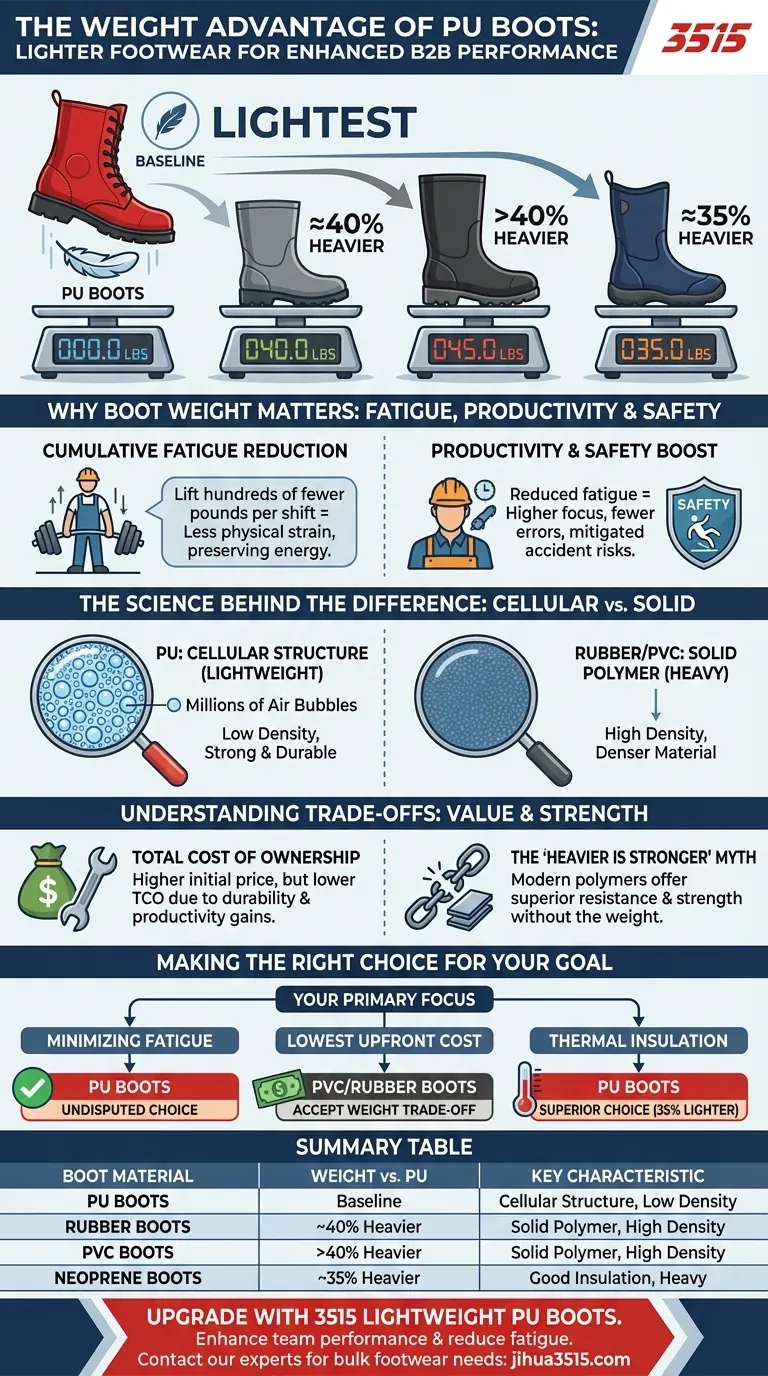In a direct comparison, Polyurethane (PU) boots are significantly lighter than models made from traditional materials. Based on material density, PU boots are approximately 40% lighter than rubber boots, more than 40% lighter than PVC boots, and 35% lighter than neoprene boots.
The significant weight reduction in PU boots is not just a comfort feature; it's a critical performance advantage. This translates directly to reduced user fatigue and increased productivity over long periods of demanding work.

Why Boot Weight is a Critical Factor
The weight of your footwear has a cumulative effect that extends far beyond initial comfort. Over the course of a workday, this difference becomes a primary driver of performance and safety.
The Direct Link to User Fatigue
An employee lifts their feet thousands of times each day. A boot that is 40% lighter may not feel different for the first few steps, but it results in lifting hundreds, if not thousands, of fewer pounds over an entire shift.
This reduction in workload directly minimizes physical strain on the legs, back, and joints. Less energy is expended on simply moving, preserving it for the actual task at hand.
Impact on Productivity and Safety
Reduced fatigue is directly correlated with higher productivity and focus. A worker who is less physically drained at the end of the day is more likely to maintain a consistent pace and make fewer errors.
Furthermore, fatigue is a known contributor to workplace accidents. By choosing lighter footwear, you are actively mitigating a risk factor for slips, trips, and falls.
The Science Behind the Weight Difference
The weight advantage of PU is not arbitrary; it is a direct result of its unique molecular structure compared to older, denser materials.
The Cellular Structure of PU
Polyurethane is manufactured with a "cellular" structure, meaning it is composed of millions of tiny, evenly distributed air bubbles. This creates a material that is strong and durable yet remarkably low in density.
Think of it as the difference between a solid brick (like rubber or PVC) and an advanced composite foam. The entrapped air significantly reduces weight without compromising structural integrity.
Contrasting with Traditional Materials
Materials like rubber and PVC are "solid" polymers. They lack the air-infused structure of PU, resulting in a much higher material density for the same volume.
This fundamental difference in composition is why a rubber or PVC boot will always be substantially heavier than a PU boot of the same size and thickness.
Understanding the Trade-offs
While the weight advantage of PU is clear, a comprehensive decision requires evaluating all factors. The choice of any industrial material involves balancing its primary benefits against other considerations.
Weight vs. Total Cost of Ownership
Advanced materials like PU can sometimes have a higher initial purchase price than basic PVC or rubber boots.
However, this initial cost should be weighed against the long-term value. Increased durability and the productivity gains from reduced worker fatigue often result in a lower total cost of ownership over the lifespan of the boot.
The Myth of "Heavier is Stronger"
There is a common misconception that heavier boots are inherently tougher. Modern material science has proven this to be incorrect.
Advanced polymers like polyurethane can offer superior resistance to abrasion, chemicals, and cracking while being significantly lighter. The strength of a boot is a function of its chemical engineering, not its weight.
Making the Right Choice for Your Goal
Your ideal boot material depends on balancing the critical need for low weight against the specific demands and budget of your operation.
- If your primary focus is minimizing all-day fatigue: PU is the undisputed choice due to its significant weight advantage over all other common materials.
- If your primary focus is the lowest possible upfront cost: Traditional PVC or rubber boots may be more budget-friendly, but you must accept the trade-off of significantly higher weight and associated fatigue.
- If your primary focus is thermal insulation: Both neoprene and PU offer excellent insulation, but PU achieves this at a 35% lower weight, making it the superior choice for cold environments.
By understanding the fundamental relationship between material science and user fatigue, you can confidently select footwear that enhances both safety and performance.
Summary Table:
| Boot Material | Weight Comparison to PU Boots | Key Characteristic |
|---|---|---|
| PU Boots | Baseline (Lightest) | Cellular structure with air bubbles for low density |
| Rubber Boots | ~40% Heavier | Solid polymer, high density |
| PVC Boots | >40% Heavier | Solid polymer, high density |
| Neoprene Boots | ~35% Heavier | Good insulation, but heavier than PU |
Upgrade your team's performance with lightweight PU boots from 3515.
As a large-scale manufacturer, we produce a comprehensive range of durable, high-performance footwear designed specifically to reduce fatigue for distributors, brand owners, and bulk clients. Our advanced PU boots combine significant weight savings with the toughness required for demanding work environments.
Let us help you enhance safety and productivity. Contact our experts today to discuss your bulk footwear needs and request a quote.
Visual Guide

Related Products
- Premium Flame-Retardant Waterproof Safety Boots and Shoes
- Premium High-Cut Waterproof Safety Boots Manufacturing & Wholesale Solutions
- High Performance Fire-Retardant Waterproof Safety Boots
- Heavy-Duty Waterproof Nubuck Safety Boots Safety Shoes for Bulk Supply
- Premium Wholesale Tactical Style Safety Shoes Boots with Quick Lacing
People Also Ask
- How does repeated exposure to high temperatures damage safety boots? Avoid Costly Structural Failures
- How do some boots combine materials for better performance? Achieve Superior Safety & Comfort
- What are the benefits of proper safety footwear beyond physical protection? Boost Productivity & Morale
- What is the impact of incorrect specification on safety boots? Avoid Costly Injuries and Non-Compliance
- What are the advantages of rubber soles in safety boots? Unbeatable Grip & Durability



















